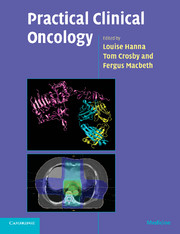Book contents
- Frontmatter
- Contents
- List of contributors
- Preface
- Acknowledgements
- Abbreviations
- 1 Practical issues in cytotoxic chemotherapy usage
- 2 Biological treatments in cancer
- 3 Hormones in cancer
- 4 Radiotherapy planning
- 5 Research in cancer
- 6 Oncological emergencies
- 7 Palliative care
- 8 Head and neck
- 9 Oesophagus
- 10 Stomach
- 11 Liver, gallbladder and biliary tract
- 12 Exocrine pancreas
- 13 Colon and rectum
- 14 Anus
- 15 Gastrointestinal stromal tumours
- 16 Breast
- 17 Kidney
- 18 Bladder
- 19 Prostate
- 20 Testis
- 21 Penis
- 22 Ovary
- 23 Body of the uterus
- 24 Cervix
- 25 Vagina
- 26 Vulva
- 27 Gestational trophoblast tumours
- 28 Lung
- 29 Mesothelioma
- 30 Soft tissue and bone tumours in adults
- 31 The lymphomas and myeloma
- 32 Central nervous system
- 33 Skin cancer other than melanoma
- 34 Melanoma
- 35 Thyroid
- 36 Neuroendocrine tumours
- 37 Cancer in children
- 38 Cancer of unknown primary
- 39 The use of radiotherapy in the treatment of benign conditions
- Multiple choice questions
- Multiple choice answers
- Index
- References
27 - Gestational trophoblast tumours
Published online by Cambridge University Press: 23 December 2009
- Frontmatter
- Contents
- List of contributors
- Preface
- Acknowledgements
- Abbreviations
- 1 Practical issues in cytotoxic chemotherapy usage
- 2 Biological treatments in cancer
- 3 Hormones in cancer
- 4 Radiotherapy planning
- 5 Research in cancer
- 6 Oncological emergencies
- 7 Palliative care
- 8 Head and neck
- 9 Oesophagus
- 10 Stomach
- 11 Liver, gallbladder and biliary tract
- 12 Exocrine pancreas
- 13 Colon and rectum
- 14 Anus
- 15 Gastrointestinal stromal tumours
- 16 Breast
- 17 Kidney
- 18 Bladder
- 19 Prostate
- 20 Testis
- 21 Penis
- 22 Ovary
- 23 Body of the uterus
- 24 Cervix
- 25 Vagina
- 26 Vulva
- 27 Gestational trophoblast tumours
- 28 Lung
- 29 Mesothelioma
- 30 Soft tissue and bone tumours in adults
- 31 The lymphomas and myeloma
- 32 Central nervous system
- 33 Skin cancer other than melanoma
- 34 Melanoma
- 35 Thyroid
- 36 Neuroendocrine tumours
- 37 Cancer in children
- 38 Cancer of unknown primary
- 39 The use of radiotherapy in the treatment of benign conditions
- Multiple choice questions
- Multiple choice answers
- Index
- References
Summary
Introduction
Gestational trophoblast tumours (GTTs) are a group of rare but highly curable diseases. The diagnoses form a spectrum from the rarely malignant partial molar pregnancy through to the aggressive malignancies of choriocarcinoma and placental site trophoblast tumour. Fortunately, with effective treatment, nearly all patients can be cured, even those presenting with advanced metastatic disease.
To provide an optimal service for this rare malignancy, the Department of Health in the UK directly funds a national human chorionic gonadotrophin (HCG) surveillance programme for all molar pregnancy patients as well as a follow-up service for treated GTT patients. The medical treatment of GTT in the UK is also centralised; there are two centres, one at Weston Park Hospital in Sheffield and the other at Charing Cross Hospital in London.
Although the main clinical care for GTTs is centralised, it remains important for all UK oncologists to have a working knowledge of GTT because choriocarcinoma and placental site trophoblast tumour (PSTT) can occur as malignancies of unknown primary with a wide range of presentations. In these patients, early involvement from the local oncology team in achieving the correct diagnosis can be lifesaving.
The pattern of GTT management in other countries varies; some countries have established centralised care, whereas, in many other countries, patients are treated locally by doctors who are likely to only see a case every few years.
- Type
- Chapter
- Information
- Practical Clinical Oncology , pp. 304 - 312Publisher: Cambridge University PressPrint publication year: 2008



